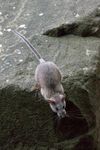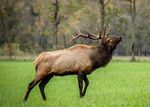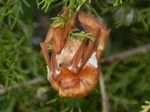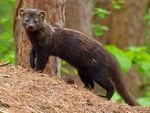2019 Lancaster County Junior Envirothon Forest Mammals
←
→
Page content transcription
If your browser does not render page correctly, please read the page content below
2019 Lancaster County Junior Envirothon
Forest Mammals
RED BAT The Red Bat is recognized by its bright
rusty colored coat of hair. While some bats do roost in
caves or buildings, the Red Bat would prefer to rest or
roost in a forest of trees. The reddish color of its coat
allow it to blend in or become camouflage among the
leaves of trees. Even against a green leaf, the bat hanging
upside down simply appears like a dead leaf or a pine
cone. The Red Bat prefers to live alone except during
mating season or when migrating to southern forests
during the nights in September and October. Nocturnal,
the Red Bat preys on moths, flies, bugs, beetles, crickets, and cicadas. They capture and eat their
prey from the air while flying, by finding it on tree leaves, or by finding it on the ground. The
female Red Bat could give birth to two sets twins each year, unlike most bats which have one
baby bat at a time.
FISHER A carnivorous mammal, the Fisher is
swift and graceful as it climbs trees. A Fisher is known
as an arboreal mammal because it lives in trees and
requires continuous forested areas to survive. Fishers
choose cavities or holes in trees to make their home.
They choose to live alone for the majority of the year.
This allows them to be opportunistic predators. This
means they select prey based on its abundance or ease in
catching in. The diversity of prey includes rabbits,
squirrels, porcupines, and rodents. Fishers are also
known to scavenge for food or consume fruits and nuts
that may be available. However, fishing is not a favorite food as its name implies. Rarely would
a Fisher take a fish to eat. In fact, its name is thought to have originated with European settlers
who felt it looked similar to a European skunk named ‘fichet’. The Fisher is a furbearer for
humans. Over harvesting for the Fisher’s fur along with forest destruction caused a significant
decline of its population to the point of extirpation. Today Pennsylvania the Game Commission
is working to restore its habitat and have successfully reintroduced the Fisher to the state.
PURCUPINE A member of the rodent
family, the forest is the perfect home for a
Porcupine. Tree bark is a favorite food. During the
summer a diet of tree bark can also include grasses,
flowers, leaves, roots, and seeds of plants. Its
blackish brown body is armored by quills as it
moves slowly on short strong legs with hairless
soles of its feet. One porcupine could carry up to
30,000 on its body. While relaxed the quills lie
smoothly on its body. When feeling threatened, its
1muscles contract making the quills rise. Any quill that is lost is replaced. The Porcupine can’t
actually throw its quills like cartoons might illustrate. Instead the quills as loosely attached to
the skin and dislodge easily on contact which makes them stick in the victim’s flesh. Its eye
sight isn’t very good however; its sense of smell is quite good. A porcupine can swim; its quills
are filled with air and help it to float. The Porcupine is a vegetarian but does crave salt. Sadly
many are hit along roadway where salt has been use to melt ice. While hiking in the woods a
human may hear the sounds of a Porcupine hidden high above in a tree. Their calls can carry up
to a quarter of mile. Calls include groans, shrieks, barks, and whining. In winter, Porcupines
seek dens to protect them from winter weather and predators. They’ve been known to live 10-12
years in the wild.
BOBCAT The Bobcat is our state’s only feline
predator. A good predator with sharp senses of sight,
smell, and hearing, the Bobcat has four large canine
teeth and five retractable, hooked claws on each front
foot. A short bobbed tail is just one characteristic of a
Bobcat. It also has black tipped ears with a ruff of fur
that extends out and downward from its ears. A female
Bobcat has 1-4 kittens in spring. She guards the litter
from predators in dens, caves, and hollow logs. Forests
with some open canopy space that allow for diverse prey
are favorite habitats in the mountainous part of Pennsylvania. Bobcats are nocturnal and prey on
small animals like mice, and squirrels along with porcupines, mink, muskrat, skunk, fish, and
fox. Their back legs are longer than their front legs. The Bobcat is good swimmer, an excellent
climber, and can jump a creek or fallen log with strong hind legs.
GRAY FOX A carnivore, the Gray Fox is a part of
the same family as dogs, coyotes, and wolves. The
Gray Fox’s extremely sharp senses of sight, smell
and hearing enable it to be a smart nocturnal
predator. In Pennsylvania the Red Fox is often found
in fields and meadows while the Gray Fox enjoys
forests. The hair coat of the Gray Fox is suited for
tree like camouflage. Its coat is a gray grizzled or
wiry textured hair with tan undercoat. It tail is long
and bushy with a black streak that runs to its black tip of the tail. The Gray Fox’s legs are a bit
longer than the Red Fox. The Gray Fox can climb trees. It is the only member of canine or dog
family with this ability. The Gray Fox is an ‘opportunity’ hunter. This means they’ll eat
whatever is easy to obtain. They will also scavenge for food, especially in winter. It will cache
(meaning hide and store) uneaten food by burying it. Scientists estimate that a fox can travel
about 5 miles in search of food during the winter. The Gray Fox will den underground. A
lifespan of 10-12 years is possible if food, water, and shelter are available.
2PINE MARTEN The Pine Marten is a member of the
weasel family. Its body is long and lean which is
designed to leap through trees in an older or mature
forest. It has sharp claws that help it to grip and hang on
to branches or climb up a tree trunk. A Pine Marten is a
nocturnal predator and using its sharp teeth and keen
hearing to hunt prey. While Pine Martens can be found
hunting in trees, they also climb about piles of rocks and
tree stumps making a den in rock formations. Like some
other mammals on the study list, the Pine Marten is an
‘opportunity’ hunter taking time to eat whatever it can
catch including birds, squirrels, sometimes rabbit, along with berries, and bird eggs. Pine Marten
populations are challenged by habitat deforestation. Communities that want to help Pine
Martens protect forest areas and make sure wood harvested from a boreal forest isn’t taking
critical habitat.
COYOTE The Coyote of Pennsylvania is the
largest canine found in the state. Coyotes are found
throughout the United States. Those living in the
eastern United States are larger than coyotes living in
western states. The hair coat of a Coyote is a blend of
blond, brown, gray, and black colors. Its ears are
always standing up listening and its bottle brush tail is
usually in a downward position. It normally has yellow
eyes, while every now and then some coyotes are born
with brown eyes. A Coyote will mate with one coyote
for life. A female coyote will design a den beneath an overturned tree, a rock pile, or an old fox
den. She has 5-7 pups each year. Coyotes use a variety of yips, barks, and howls to
communicate with one another. Sometimes they use their voices to gather as a larger pack to
hunt. Once Coyotes mainly used forests for shelter, however, today coyotes are found in forests,
fields, and even cities. Food habits include deer, rabbits, woodchucks, and smaller mammals. In
addition to mammals, Coyotes also eat plant matter such as fruits. A Coyote’s favorite habitat is
at the edge of a forest with brushy cover where it can hunt for food easily.
3SNOWSHOE HARE The Snowshoe Hare is also
called the Varying Hare because twice a year it changes it
pelt coloration. The name Snowshoe refers to its large
furry hind feet that let it move through snow easily. It is
the big hare of Pennsylvania’s north woods. The
Snowshoe Hare is not a true rabbit. The way the
Snowshoe Hare digests food is structurally very different
from a rabbit. The hare has a brown phase, where its fur
coat is gray brown throughout late spring and summer.
Molting begins in fall. As the hare molts, the brown hair
slowly falls out and is replaced with white hair. Then in
spring the molt begins again as it switches to brown hair
again. The molt or switch in color phases is completely
connected to the length of light during the daytime. In
fall as daylight become shorter, the hare’s eyes receive
light for shorter and shorter time periods. This tells its
brain to turn off pigment or color in the new fur growing
in. In spring when daylight lengthens, it reserves the
process with new brown hair coat. The hare’s hearing is
excellent with extra-large ears to catch sounds. Eyes can
see a wide view as they as set on the sides of the head.
To see and hear even better, the hare can stand and
balance on its hind legs. Plants and woody vegetation
make up its diet, as the hare is nocturnal.
ELK Before white settlers arrived in Pennsylvania,
Elk lived everywhere in the state. Elk became
extirpated from the state after development and people
populations grew. Today the state’s Elk population is
from our western states and was reintroduced in the
early 1900’s. In North America the moose is the largest
member of the deer family and the Elk is the second
largest. Elk grow a different hair coat for summer than
their winter coat. Both the male, called bulls, and the
females, called cows, have the same color coat with
bulls growing antlers each year. Cow Elk bark to communicate with their young called calves.
Bull Elk are known for their call known as bulging. Bulging starts with a low bellow that goes
up on a scale to a high note, which is held until it runs out of breath. Cows will also bugle at
times. Elk are grazers. They eat a variety of grasses. In winter, they’ll paw into snow to find
grass or they will nibble on twigs, and the bark of trees. While they enjoy feeding in meadows
and fields, they will seek shelter and cover in amongst trees and forests. Bull Elk will challenge
other bulls to a pushing match with using their antlers. Rarely is anyone injured, the weaker bull
will usually back up and trot away. Elk have been known to live for 20 years in the wild; good
habitat that includes plenty of food and cover is important. The PA Game Commission
continues work to improve their habitat choices.
4NORTHERN FLYING SQUIRREL Northern
Flying Squirrels are mainly arboreal meaning they live in
trees. Finding food sometimes brings them to the forest
floor. It’s hard to spot a Northern Flying Squirrel; they are
nocturnal. They nest in hollow tree limbs, tree cavities, or
large bird nests. Northern Flying Squirrels eat nuts, seeds,
tree blossoms, fruits, berries, ferns, and fungi. They will
store nuts in their nest or den or bury them in the ground.
Predators of this type of squirrel include owls, feral house
cats, foxes, coyotes, skunks, raccoons, and the black rat
snake. The loss and fragmentation of old growth forests
may be causing a decline in the population of the Northern Flying Squirrel in Pennsylvania. It is
considered a threatened species in our state. Although they have flying in their name, Northern
Flying Squirrels do not truly fly. A furred fleshy membrane that is attached from wrist of the
foreleg to the ankles of the hind leg allows the squirrel to glide from tree to tree. Their fur about
their back is silky grey with cinnamon brown colors added in. Their belly is light grey and
white. Large black eyes help them to see well at night.
SHORT TAILED WEASEL The Short Tailed
Weasel is also known as the ermine or Bonaparte’s
weasel (named for Napoleon Bonaparte who was
shorter in stature). Small at only 9-15 inches in length,
its short tail sets it apart along with soft fur that is made
up of underfur that is short and guard hairs that are
longer. The Short Tailed Weasel molts similarly to the
Snowshoe Hare. In spring, a dark brown hair coat
grows in, while in autumn as daylight becomes shorter,
the hair coat drops out and a white coat grows in for
winter. It is alert at all times as well as being curious
and bold. They make many different vocal sounds that
include hisses, purring, chatter, and screeches. When
annoyed they might stamped their feet of give off a
musk odor. The Short Tailed Weasel can swim to
pursue prey in water as well as climb trees. They have
a loping gait that causes their back to arch as they move. In forests, they prey on mice, rats,
cottontail rabbits, frogs, small snakes, birds, insects, and even earthworms. Though they are
predators, they themselves can be preyed on by other predators such as fox, coyote, bobcats, and
owls. The Short Tailed Weasel will den beneath a stone wall, rock pile, fallen tree, or in an
abandoned building. Their short legs have five small clawed toes on each foot. Senses of sight,
smell, and hearing are very strong which makes their instinct keen. They are active, aggressive
to hunt and quick. They are mainly nocturnal hunters however, based on food availability they
may be seen hunting during the day too.
5ALLEGHENY WOOD RAT The Allegheny Wood Rat
lives in remote rocky habitats of old forests in the state. The
Allegheny Wood Rat has little in common with the invasive
Norway rate that enjoys living right alongside humans. The
Allegheny Wood Rat enjoys wilderness spaces. Caves, rocky cliffs,
boulder fields with deep crevices and underground chambers are the
favorites of the Allegheny Wood Rat. They eat leaves, berries, nuts,
ferns, and fungi. They are nocturnal and feed in a range of about an
acre of land. They will hoard food near their nests, meaning they
stock pile food. Their nest is built from parts of the forest including
bark scraps, twigs, leaves, and moss. Often they will have two
living area nests, each about 5 inches across and lined with shredded
grasses. The nest is used year round and for the animal’s entire life.
Since they hoard food, they tend to also collect treasures like old
mammal skulls, feathers, bottle caps, coins, rags, pieces of broken
china. These objects are hidden in the nest heaped up outside. This is how the Allegheny Wood
Rat gets its nickname “pack rat” from its habit of packing off items to its nest. It’s also known as
a “trade rat” as it sometimes gets distracted while collecting food. If it comes upon an interesting
object while carrying a twig, or berry, it may leave it behind to pick up the new item, like a
camper’s spoon, or even car keys. They ward off other rats from using their nest sites by
thumping their tails on the ground, chattering their teeth, or stumping their hind feet. Due to
habitat loss, the Allegheny Wood Rat is a threatened species and has been proposed as a
candidate for the federal endangered species list.
6You can also read



























































